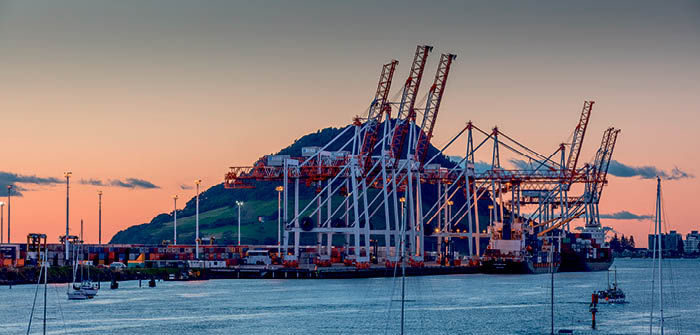Port of Tauranga reported strong first quarter trade volume growth at its recent AGM, with unaudited Group Net Profit After Tax (NPAT) up 4.6 percent on the previous corresponding period.
“Based on the first quarter’s performance, and notwithstanding any significant market changes, we expect full year earnings to be between $96 million and $101 million,” said port chief executive Mark Cairns.
This compares with a record NPAT of $93.4 million for the year ended June 2018. Group NPAT for the year increased 13 percent to $94.3 million.
“We completed our capacity expansion programme in 2016 and the effects were almost immediate.”
– David Pilkington
First quarter volumes grew 8.3 percent on the same period last year, with the port handling more than 6.6 million tonnes of cargo from 1 July 2018 to 30 September 2018.
The increase was driven by log exports, which were 14.7 percent higher compared with the previous corresponding period, and transshipped containers, which increased 11.4 percent in volume.
Dairy exports decreased due to seasonal fluctuations and were 7.1 percent less than the same period last year. Overall container numbers increased 0.7 percent for the three month period, to just under 296,000 TEU (20 foot equivalent units).
Cairns says the port is now looking to the next stage of cargo growth and has ordered a ninth container crane for delivery in 2020.
It also intends to extend its container berths south of the existing wharves on existing port-owned land.
Of its 190 ha in landholdings, the port has approximately 40 ha of land still available to accommodate cargo growth.
Port of Tauranga’s hub port strategy is gaining momentum, with growing cargo volumes and increased transhipment driving record results in the year to 30 June 2018.
New Zealand’s largest, fastest growing and most productive port saw container volumes increase 8.9 percent to nearly 1.2 million TEUs, while overall cargo volumes increased 10.2 percent to almost 24.5 million tonnes.
Record year in 2017/18
Earlier in the year, the port announced record annual earnings as freight volumes continued to increase and shippers utilised its hub port status.
The strong NPAT of $94.3 million reflected good performance from the port’s subsidiary and associate companies with earnings up 11.9 percent to $16.4 million.
The results were lifted by increased volumes across all major cargo categories, including export logs (up 14.3 percent in volume) and dairy products (up four percent).
Transhipment of containers, when they are transferred from one service to another at Tauranga, grew 23.3 percent during the last financial year, demonstrating the entrenchment of the “hub and feeder “ model in New Zealand, said port chairman David Pilkington.
“This growth is a direct result of Port of Tauranga’s six-year investment in building capacity to accommodate larger vessels.
“We completed our capacity expansion programme in 2016 and the effects were almost immediate. We are seeing larger container vessels, as well as larger bulk cargo and passenger ships.”
With the fast container service connections between Tauranga and North Asia, North America and South America, shippers in Australia and New Zealand have increasingly been using Tauranga
as a hub port.
Containers transhipped from other New Zealand ports grew 54.7 percent compared with the previous year.
The port said it now handled 40 percent of all containers in New Zealand.
Cargo trends
In the 2017/18 financial year, imports increased 13.7 percent to 9.0 million tonnes and exports increased 8.2 percent to 15.4 million tonnes for the year. Total ship visits increased 5.8 percent.
Log exports increased 14.3 percent to 6.3 million tonnes with sawn timber exports also up in volume, by 10.3 percent.
Forestry products were still fetching record prices internationally during the period, the port said.
Dairy product exports in the last financial year were up four percent to 2.3 million tonnes. Imports of dairy industry food supplements increased 18.2 percent, and fertiliser imports increased 16.4 percent, reflecting a strong sector.
Other primary product sectors also fared well, with frozen meat exports increasing 11.3 percent and apples increasing 20.9 percent.
Cement imports increased 18.9 percent while steel exports increased by 25 percent, reflecting the past couple of years of strong construction growth.
Oil product imports increased 9.3 percent and other bulk liquids increased 39.9 percent.
The number of cars and other vehicles imported at Port of Tauranga doubled compared with the previous year.
And while kiwifruit volumes were down 5.8 percent due to a seasonal drop in green kiwifruit, an increasing proportion of the kiwifruit crop was being shipped via refrigerated container.
The number of TEUs increased 27.6 percent compared with the previous year.
Operational developments
Cairns noted that the port’s container terminal now has 2634 refrigerated container (reefer) connection points, which are supplemented in the peak season with 12 generators each supplying power to 35 containers.
The Port also opened a new purpose-built coolstore at Mount Maunganui to handle kiwifruit and other chilled cargoes.
“We believe we have the largest reefer capacity in Australasia, demonstrating the significance of the volumes we are handling.”
The Port maintained its industry-leading record for productivity, with a net crane rate for the year to 30 June 2018 of 35.5 moves per hour (compared with the reported national average of 33.5 moves per hour and Australian rate of 28.9 moves per hour).
















